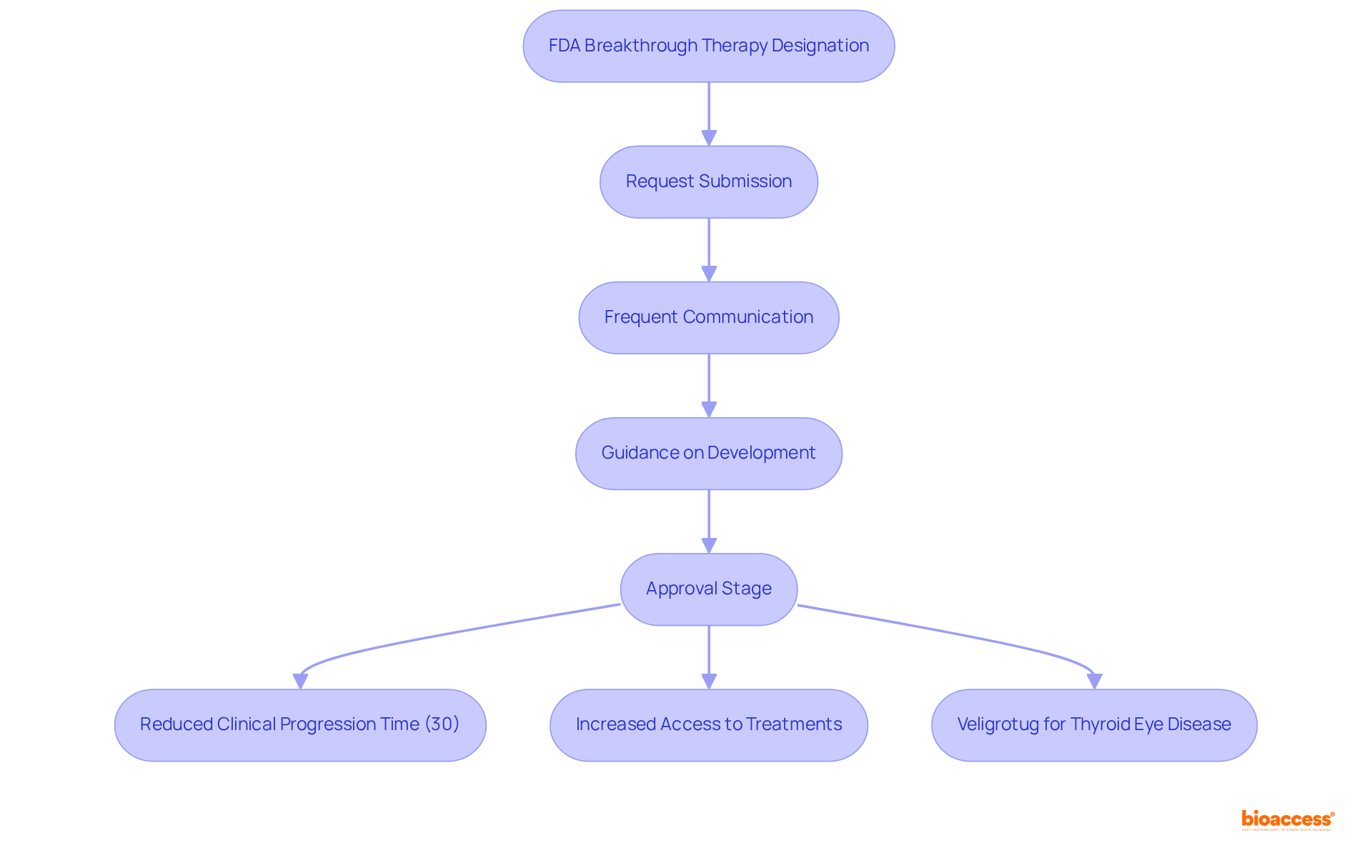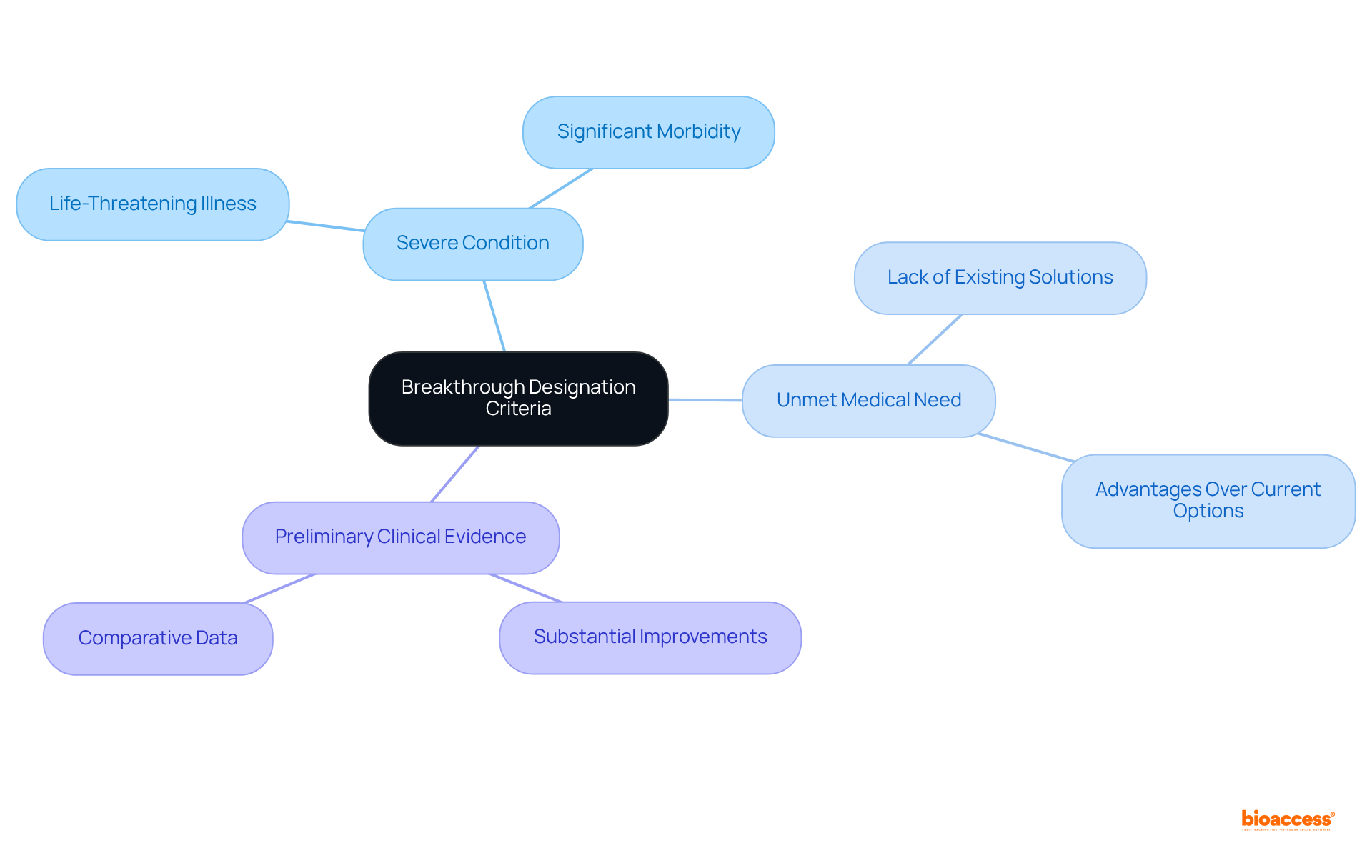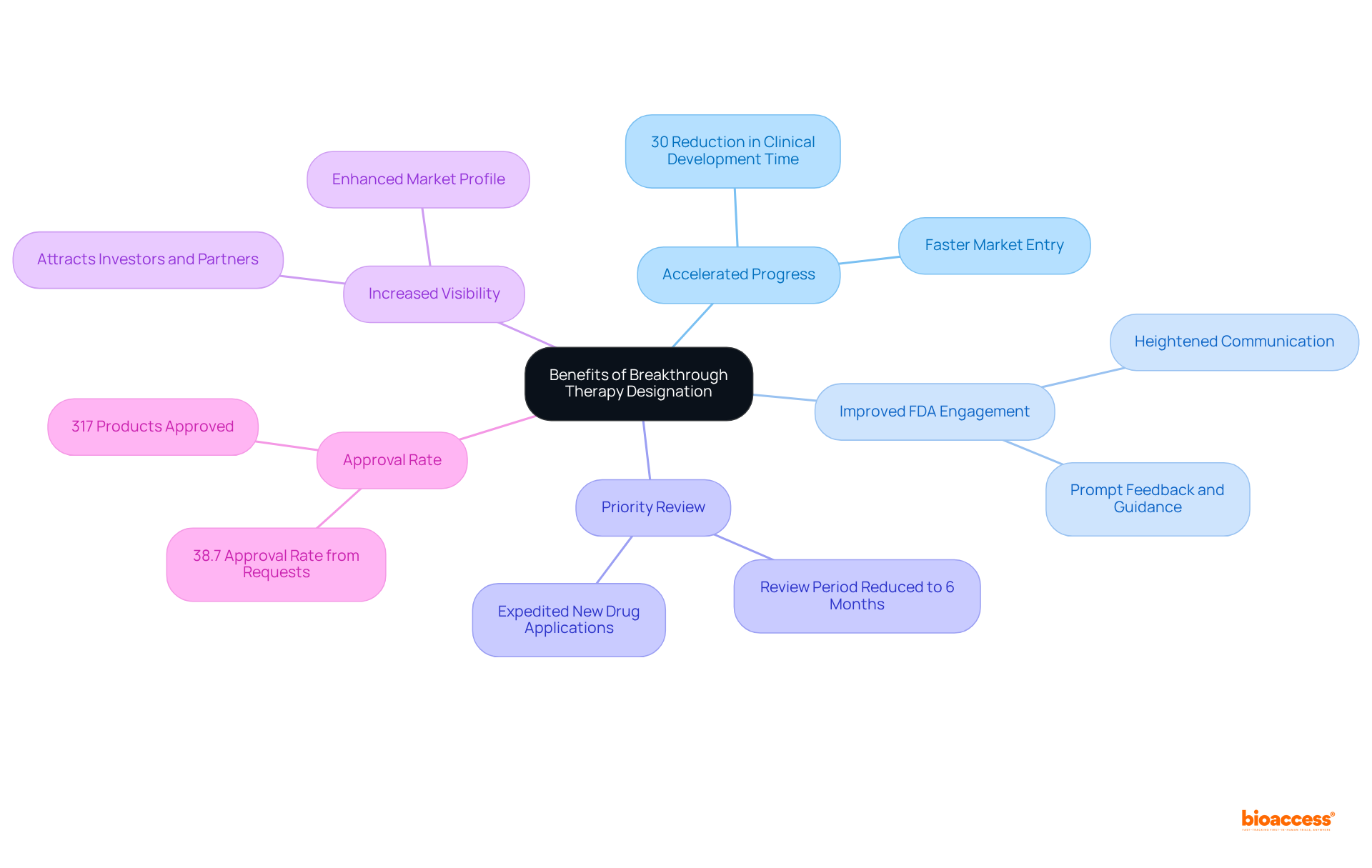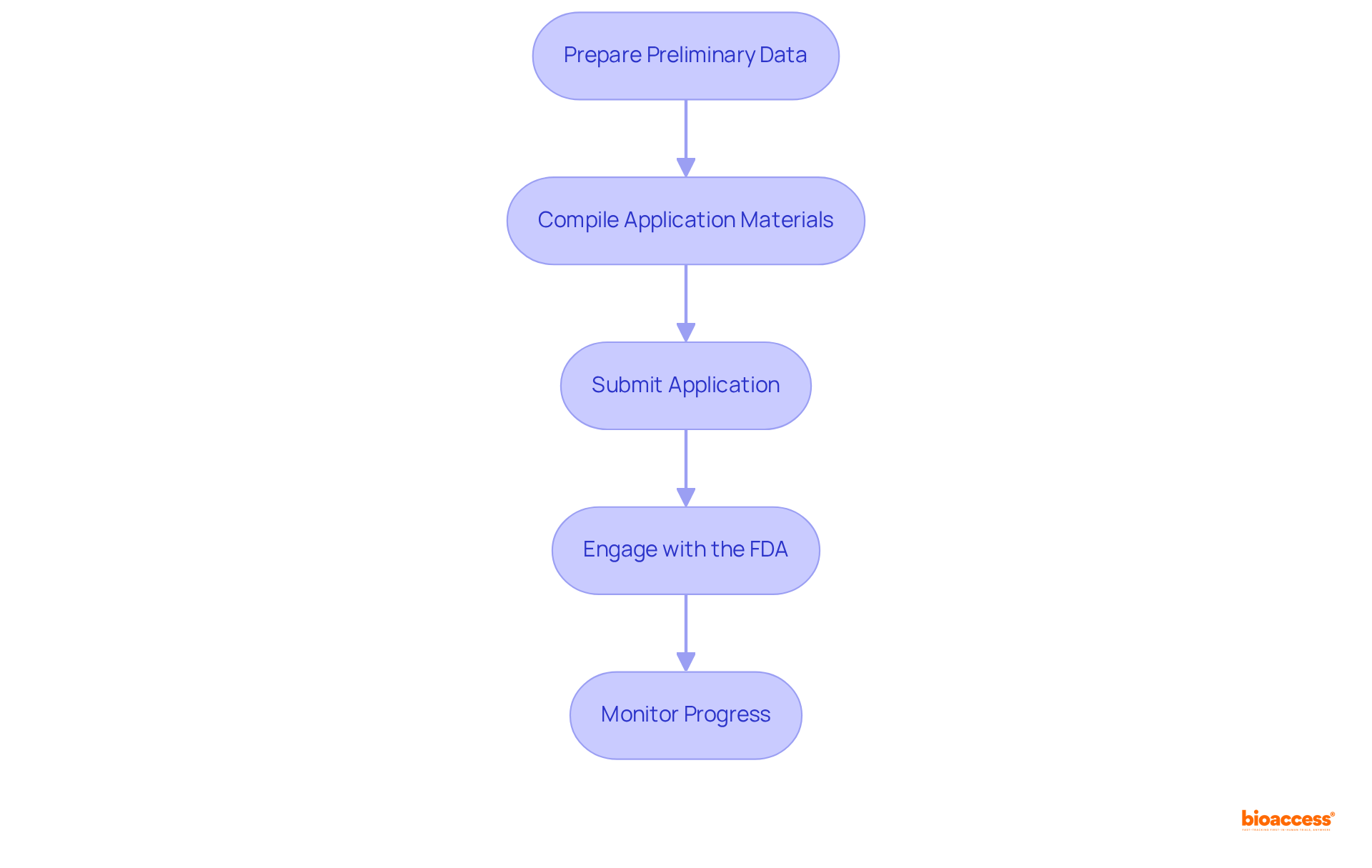


The article "Mastering Breakthrough Designation: Steps for Clinical Success" underscores the critical role of Breakthrough Therapy Designation (BTD) in accelerating the development of therapies aimed at serious medical conditions. It highlights that BTD not only facilitates more efficient communication with the FDA but also reduces clinical progression time by 30%. This substantial reduction significantly hastens the availability of innovative treatments, ultimately benefiting patients in need.
The urgency of advancing medical treatments for severe conditions has never been more pronounced as healthcare systems grapple with unmet needs and the demand for innovative therapies.
Breakthrough Therapy Designation, a strategic initiative by the FDA, serves as a beacon of hope, streamlining the path for promising treatments to reach patients faster.
However, in a competitive landscape with stringent criteria, stakeholders must effectively navigate the complexities of this designation to ensure their therapies not only qualify but thrive in the clinical arena.
This article will explore the significance of this designation and its implications for the future of medical innovation.
Breakthrough designation represents a pivotal initiative established by the U.S. Food and Drug Administration (FDA) to expedite the development and evaluation of therapies for serious conditions with unmet medical needs. The breakthrough designation is essential as it facilitates more frequent communication between sponsors and the FDA, offering critical guidance on effective drug development strategies. By leveraging breakthrough designation, stakeholders can significantly reduce the time required for innovative treatments to reach patients, thereby enhancing patient outcomes and advancing medical knowledge.
The impact of the breakthrough designation is underscored by recent data indicating that the program reduces late-stage clinical progression time by 30%, as revealed in an analysis of drugs approved from 2006 to 2020. As of June 30, 2024, the FDA has received 1,516 requests for breakthrough designation, granting 587 of these, which resulted in 317 approvals. This illustrates the program's effectiveness in expediting medical advancements, which have received breakthrough designation. A notable example is Viridian Therapeutics' veligrotug, which received breakthrough designation for the treatment of Thyroid Eye Disease and successfully met all primary and secondary endpoints in pivotal trials, positioning it as a potential treatment-of-choice. The anticipated Biologics License Application (BLA) submission on May 7, 2025, further emphasizes the program's role in facilitating timely access to critical treatments, which may support its request for breakthrough designation.
Steve Mahoney, President and CEO, remarked, "The FDA’s decision to grant veli a breakthrough designation underscores that veli may offer substantial improvement over existing treatments, and we believe it reinforces veli’s potential to be a differentiated, treatment-of-choice for patients living with TED." In conclusion, the breakthrough designation (BTD) not only streamlines the development process but also enhances communication between the FDA and sponsors, ensuring that treatments with significant advancements over current options can be delivered to patients more efficiently.

To qualify for breakthrough designation, a treatment must satisfy several critical criteria. First, it must address a Severe Condition, focusing on a critical or life-threatening illness. Second, there must be compelling evidence of an Unmet Medical Need, indicating either a lack of existing solutions or significant advantages over current options. Third, applicants must provide Preliminary Clinical Evidence that suggests the treatment may offer substantial improvements over existing therapies.
As of 2024, approximately 38.7% of requests for breakthrough designation have been granted, highlighting the importance of well-prepared applications that convincingly demonstrate compliance with these criteria. Companies should ensure their documentation is comprehensive and clearly articulates how their treatment meets these requirements, thereby enhancing the likelihood of receiving the designation.
Furthermore, sponsors must critically evaluate their entire program, including clinical, manufacturing, and CMC readiness, before pursuing BTD, as emphasized by specialists in the field. The FDA commits to addressing breakthrough designation requests for treatment within 60 days of receipt, making timely and strategic planning crucial for success.

The advantages of breakthrough designation are substantial and multifaceted. Firstly, the breakthrough designation enables accelerated progress, allowing companies to bring treatments to market significantly faster. Studies indicate that treatments with BTD experience a reduction in late-stage clinical progression time by approximately 30%, enhancing the overall efficiency of the drug development process.
Secondly, designated treatments benefit from improved FDA engagement, characterized by heightened communication that facilitates prompt feedback and guidance throughout the development journey. This interaction is crucial for early identification of potential issues, ensuring alignment with regulatory expectations.
Additionally, treatments that receive breakthrough designation (BTD) often qualify for priority review, which can shorten the review period for New Drug Applications (NDAs) from the FDA's standard 10 months to as little as 6 months. This expedited review process is vital for delivering life-saving treatments to patients more swiftly.
Furthermore, receiving BTD increases a company's visibility in the competitive market, attracting interest from potential investors and partners eager to support innovative therapies. This enhanced profile can lead to additional funding opportunities and strategic collaborations.
Moreover, from the 1,516 requests for breakthrough designation (BTD), 587 have been approved, resulting in a 38.7% approval rate, underscoring the program's success in facilitating drug development. Collectively, these advantages establish a more efficient pathway for providing essential treatments to patients, highlighting the significance of breakthrough designation in contemporary drug innovation.

The application process for breakthrough designation involves several critical steps that organizations must follow to improve their chances of success.
Prepare Preliminary Data: Begin by gathering and examining initial clinical information that demonstrates the treatment's potential to meet an unmet medical need. This data must indicate significant improvement over existing therapies, as the FDA mandates compelling evidence for designation.
Compile Application Materials: Next, develop a comprehensive application that encompasses all necessary documentation, including clinical trial data, safety information, and evidence of the serious condition being treated. A well-prepared application is essential; approximately 38.7% of requests have been granted, with the FDA receiving 1,516 requests and granting 587 as of June 30, 2024. This statistic underscores the importance of robust submissions.
Submit Application: Once prepared, submit the application to the FDA, ensuring that all materials are complete and comply with regulatory guidelines. The FDA commits to responding to requests within 60 days, making timely submission crucial for maintaining development momentum.
Engage with the FDA: After submission, it is vital to maintain open communication with the FDA to address any questions or requests for additional information. Timely and regular engagement can significantly enhance the likelihood of endorsement and accelerate patient access to the treatment. As Rob Maiale emphasized, sponsors must incorporate strong clinical data and comparative information on current treatments to improve collaboration with the FDA.
Monitor Progress: Finally, continuously track the application status and be prepared to respond promptly to any feedback from the FDA. Efficient resource management during this phase is critical for planning expedited timelines.
By adhering to these steps, organizations can navigate the application process more effectively, increasing their chances of obtaining breakthrough designation and ultimately expediting the introduction of innovative therapies to the market. Furthermore, securing this designation grants access to intensive FDA guidance and priority review processes, which can significantly shorten development and approval timelines.

The breakthrough therapy designation (BTD) serves as a crucial mechanism established by the FDA to accelerate the development and approval of innovative treatments for serious medical conditions. This designation fosters closer collaboration between sponsors and the FDA, streamlining the drug development process and enhancing patient access to potentially life-saving therapies. The significance of BTD lies in its ability to transform the landscape of medical treatment, ensuring that advancements reach those in need more efficiently.
Key insights regarding the criteria for obtaining breakthrough designation include:
The benefits of BTD, such as reduced clinical progression times and improved FDA engagement, further emphasize its role in expediting medical advancements. Moreover, the step-by-step guide through the application process underscores the importance of thorough preparation and proactive communication with regulatory bodies to maximize the chances of success.
Ultimately, the breakthrough therapy designation represents a vital pathway for pharmaceutical companies aiming to innovate and improve patient outcomes. As the healthcare landscape continues to evolve, stakeholders are encouraged to embrace the advantages of this designation, ensuring that promising therapies can swiftly transition from the lab to the clinic. By prioritizing the needs of patients and maintaining a focus on effective collaboration with regulatory agencies, the potential for groundbreaking treatments to transform lives becomes increasingly attainable.
What is Breakthrough Therapy Designation?
Breakthrough Therapy Designation is an initiative established by the U.S. Food and Drug Administration (FDA) to expedite the development and evaluation of therapies for serious conditions with unmet medical needs.
Why is Breakthrough Therapy Designation important?
It facilitates more frequent communication between sponsors and the FDA, providing critical guidance on effective drug development strategies, which helps reduce the time required for innovative treatments to reach patients and enhances patient outcomes.
How does Breakthrough Therapy Designation impact clinical progression?
The program has been shown to reduce late-stage clinical progression time by 30%, based on an analysis of drugs approved from 2006 to 2020.
How many requests for Breakthrough Therapy Designation has the FDA received?
As of June 30, 2024, the FDA has received 1,516 requests for breakthrough designation and has granted 587 of these requests, resulting in 317 approvals.
Can you provide an example of a drug that received Breakthrough Therapy Designation?
An example is Viridian Therapeutics' veligrotug, which received breakthrough designation for the treatment of Thyroid Eye Disease and successfully met all primary and secondary endpoints in pivotal trials.
What is the significance of the anticipated Biologics License Application (BLA) submission for veligrotug?
The anticipated BLA submission on May 7, 2025, highlights the program's role in facilitating timely access to critical treatments and may support the request for breakthrough designation.
What does the FDA's decision on veligrotug signify according to Steve Mahoney, President and CEO?
It underscores that veligrotug may offer substantial improvement over existing treatments and reinforces its potential to be a differentiated, treatment-of-choice for patients living with Thyroid Eye Disease.
How does Breakthrough Therapy Designation enhance communication between the FDA and sponsors?
It streamlines the development process by ensuring that treatments with significant advancements over current options can be delivered to patients more efficiently.